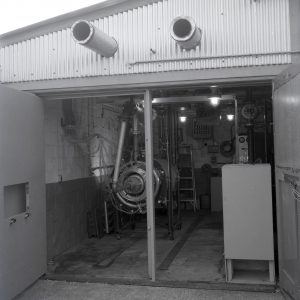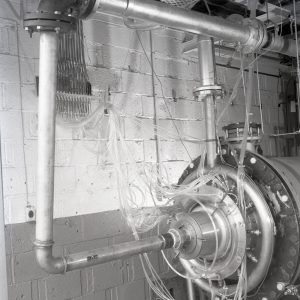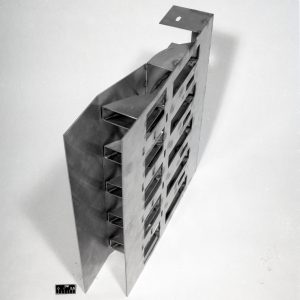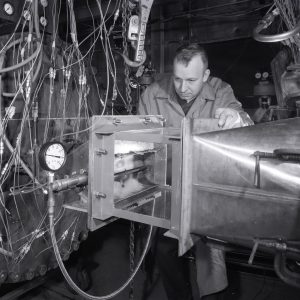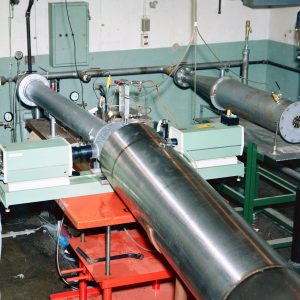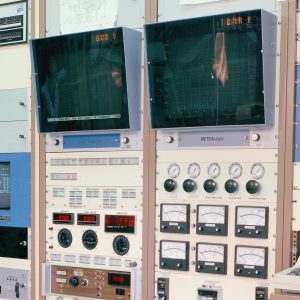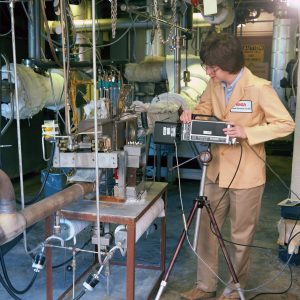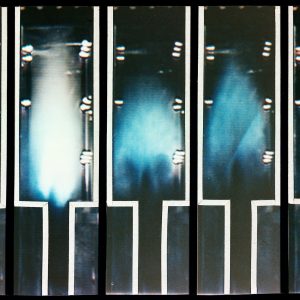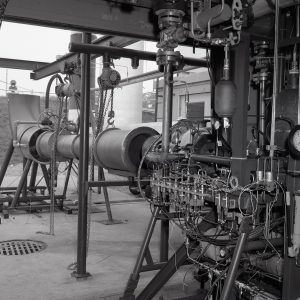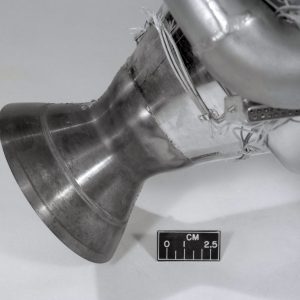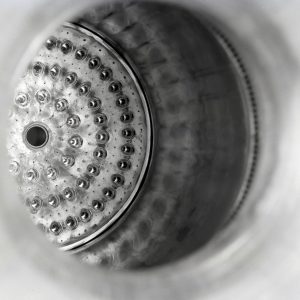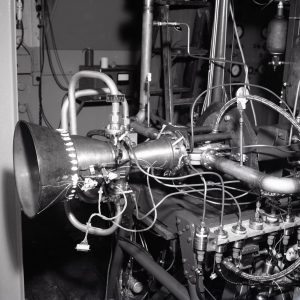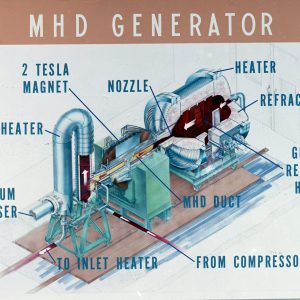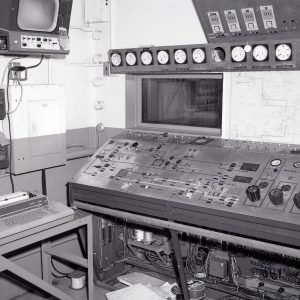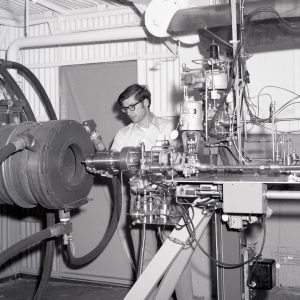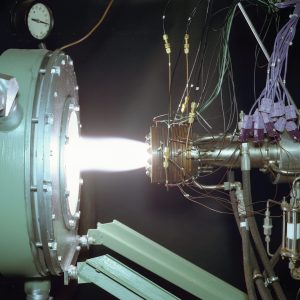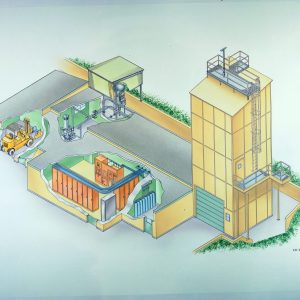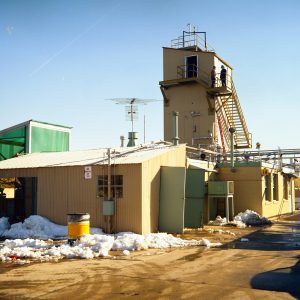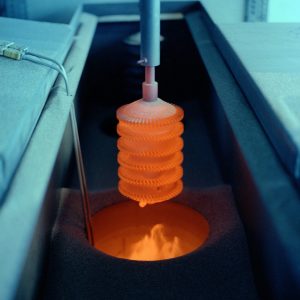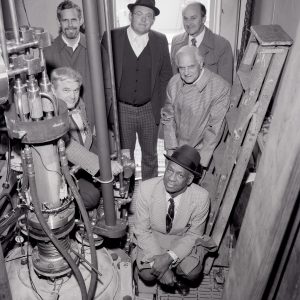New Fields of Research
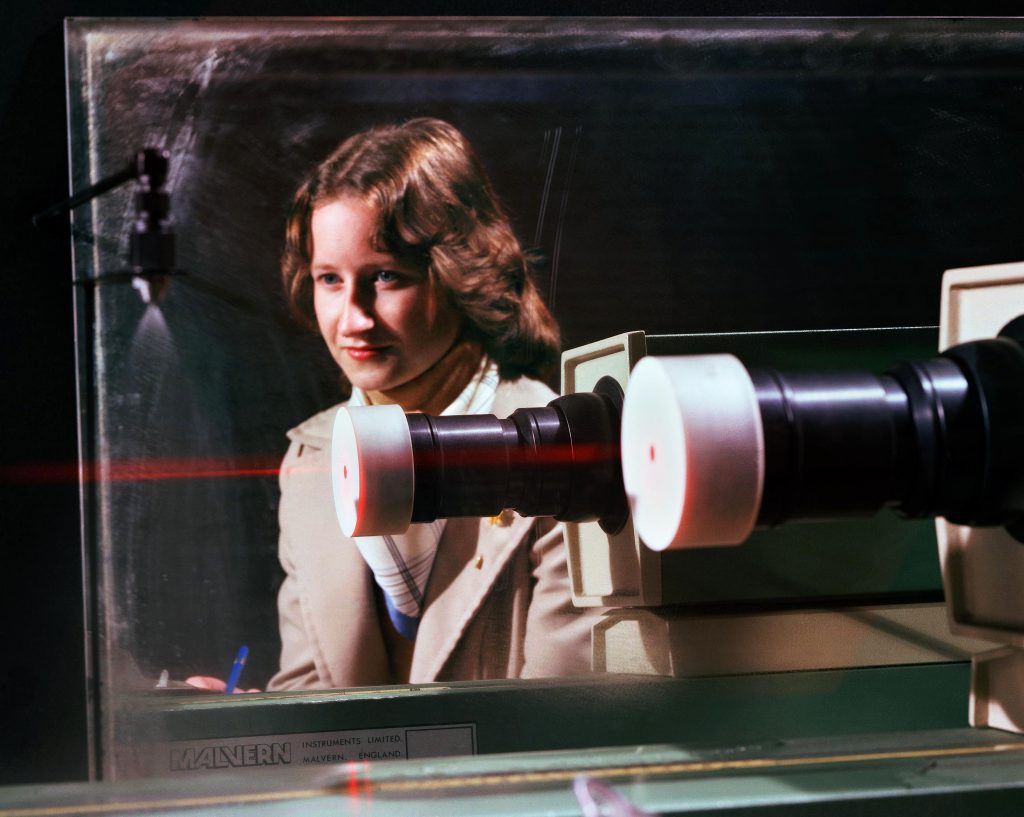
Overview
By the mid-1960s, the U.S. space program was well on its way, and the Lewis Research Center began shifting its resources from space propulsion to new aeronautical issues, such as noise and emissions. The center also began partnering with the Energy Research and Development Administration (ERDA) to address other earth-based concerns stemming from the energy crisis and environmental movement.
Activities at the Rocket Laboratory reflected these changes. For the first time, the facility supported aeronautical programs by testing aircraft engine combustors. In addition, two test cells were completely overhauled to evaluate cleaner and more efficient methods of burning coal. The Rocket Lab also continued its low-thrust propulsion work by testing thrusters for the new space shuttle program.
Combustors for Aeropropulsion
Combustors are a critical element of jet engines. They provide a chamber for the fuel to mix with high-pressure air and combust. The resulting hot gas flows through the nozzle as thrust. In the 1960s, the Lewis researchers sought to improve combustor performance and efficiency by decreasing their length, refining temperature profiles, and improving fuel injection. They also began a long-term effort to reduce combustion emissions.
Short Diffusers: Diffusers improve combustion in aircraft engines by reducing the velocity of the airflow between the compressor and the combustor. In the 1960s, engine designers believed that performance would be improved by shortening the length of the diffuser. Lewis researchers used a test rig in Cell 12 to successfully demonstrate that the use of short diffusers with wall bleed capabilities was a simpler method of controlling the airflow than variable-geometry designs.
Inlet Distortions: IIn 1969, researchers used an experimental rectangular-shaped combustor in Cell 11 to investigate several design improvements. The combustor was used to study the effect of inlet flow distortions and engine speed variations on flow from the compressor. The researchers were particularly interested in reducing radial air velocity, which produces temperature variations that could potentially damage the turbine. They first redesigned the combustor to use side-entry inlets to lower radial exit velocity and added new combustion liner slot configurations to improve film cooling. They then studied the effect inlet distortions had on the modification
Fuel Atomization: In order to reduce carbon dioxide emissions resulting from fuel-rich combustion mixtures frequently found in contemporary aircraft engines, Lewis engineers developed and successfully tested a new method of fuel injection that used the airstream velocity to atomize the fuel. The atomization reduced the amount of unburned fuel, resulting in lower carbon dioxide levels in the exhaust. It was reported that the injection of 0.25 percent of the engine airflow into the fuel nozzles could reduce emissions during idling by half.
Lewis researchers continued investigating the use of “airblast” fuel atomizing injectors in the ensuing years. In the early 1980s, Cell 21 was used to study an experimental atomizer system in which ethanol fuel was first impinged on a splash plate that directed it radially outward. The fuel was atomized as it passed through two concentric, vaned swirlers that rotated the air in opposite directions. The tests provided data on the effect of mass velocity, liquid- to- air ratio, and liquid properties on the spray characteristics.
Flashback: NASA also evaluated premixed-prevaporized combustors that operate with uniform lean fuel-to-air ratios, and thus produce lower nitric oxide and soot emissions. The combustion flame in these combustors, however, often extended into the premixing tube. This phenomena, known as flashback, can damage the combustor and increase pollution. In the early 1980s, a test rig was built in Cell 11 to provide basic data on the flashback process. Extensive testing showed that combustion instability was the primary cause of flashback, while inlet temperatures had little effect.
Documents
- Cleaner Skies Presentation at 1973 Inspection
- Gas Turbine Combustor with Air Atomizing Fuel Injector System (1969)
- Effect of Diffuser Designs on an Experimental Turbojet Combustor (1971)
- Performance of Short Length Turbojet Combustor (1971)
- Combustor Liner Film Cooling in Free-Stream Turbulence (1971)
- Study of Spray Characteristics of a Airblast Atomizer (1985)
- Combustor Flame Flashback Report (1985)
Hydrogen-Oxygen Thrusters for Shuttle
During the initial phases of the Space Shuttle definition studies in the early 1970s, several thruster concepts were proposed and evaluated for the Shuttle Attitude Control Propulsion System (ACPS). The ACPS was designed to control the orbiter’s position throughout its time on orbit and return the “flyback booster” to earth. Designers were particularly interested in liquid hydrogen-liquid oxygen systems, but there were a number of major technical issues that would have to first be resolved.
In 1974, the Rocket Lab’s Cell 21 was modified to test a hydrogen-oxygen thruster designed by Aerojet. The test program provided data on performance, thermal and hydraulics characteristics, and pulse response. The testing also demonstrated that the thruster could meet the vehicle requirement of firing 500 times per flight for 100 different missions.
Although the elimination of the flyback booster from the shuttle design negated the need for hydrogen-oxygen thrusters, NASA designers continued to be interested in hydrogen-oxygen thrusters for other applications in the 1980s, including the space station and space transfer vehicle.
Documents
Hydrogen-Oxygen Steam Generators
NASA was also working with the ERDA on a number of energy systems in the 1970s. One project studied various coal energy conversion systems that were less expensive and cleaner than contemporary coal plants. One of these alternatives was an open-cycle magnetohydrodynamic (MHD) system that offered higher efficiencies, but were more complex, and expensive to create.
In the 1970s, Lewis initiated a program to investigate one of these alternatives—the use of hydrogen-oxygen MHD steam generators. Hydrogen offered a comparatively inexpensive and pollution-free alternative, but its low flame temperature hindered electrical conductivity rates.
The first step was to evaluate hydrogen-oxygen generators at high-voltage, high Mach number, and high magnetic fields. To support the program, NASA Lewis built a new MHD power generation facility in the Engine Research Building and converted Cell 22 at the Rocket Lab into a MHD channel testing facility.
The researchers used the Cell 22 rig to conduct over 1,000 runs (up to 20 seconds) to develop interelectrode insulating materials, to measure heat losses, and to determine the fluid dynamic and electrical properties of MHD ducts and the cesium-seeded hydrogen-oxygen working fluid.
Documents
- MHD Power Generator Facility – Tech Preview
- NASA Lewis H2-O2 MHD program (1974)
- Results and progress on the NASA Lewis H2-O2 MHD program (1976)
- Temperature distributions of a cesium-seeded hydrogen-oxygen supersonic free jet (1978)
Pressurized Fluidized Coal Bed
As energy demands increased in the 1970s, NASA researchers investigated the use of fluidized- bed combustion of coal in an effort to supplement renewable energy sources while decreasing the amount of resulting pollution from the coal. Fluidized bed combustion systems are smaller in size than the traditional coal plant boilers, but also burn a variety of materials and produce lower sulfur emissions. At the time, however, fluidized beds were not an established technology. One of the primary concerns was the effect of the high temperatures on the turbine.
In 1975, Lewis engineers designed the experimental system, referred to as both the Fluidized Combustion Test rig and the Pressurized Fluidized Bed Facility, to test the effect of the hot sulfur coal gas emissions on different materials that could be used for coal plant turbine drives. The Rocket Lab’s Cell 14 underwent major modifications, including the addition of a high-bay, to accommodate the rig.
The fluidized coal bed was suspended from the high- bay with the controls, coal and sorbent feed system, and gas analyzer located below. Lewis engineers operated the system for 1,200 hours between March 1978 and June 1979. During the fluidized coal bed’s 2-year operational period, Lewis conducted over 200 different tests alternating a number of variables.
Lewis researchers first concentrated on characterizing the emissions from the coal bed under a wide range of operating conditions. Subsequent efforts tested turbine materials and the operation of a small gas turbine. The tests analyzed overall reactor performance, the effect of modifications, and the durability of materials.
The pressurized fluidized bed experiments concluded in 1979 with a successful 400-hour test of a high-speed turbine in the combustion products. The Rocket Lab testing results provided complete data on the use of a fluidized bed as a combustor. They found that the hot gas cyclone separator removed nearly all of the exhaust gas byproducts, and the limestone removed 90 percent of the sulfur oxide. Under the turbine’s normal operating conditions, all pollutants were lower than the proposed automotive emissions standards at the time.
Documents
- Lewis Pressurized, Fluidized-Bed Combustion Program–Data and Calculated Results (1982)
- Erosion/Corrosion of Airfoil Materials in the High-Velocity Effluent of a Pressurized Fluidized Coal Combustor (1978)

